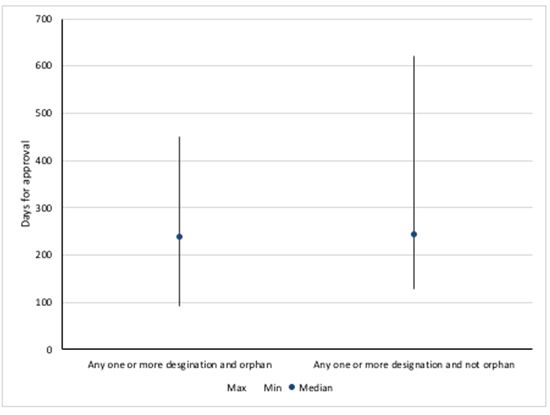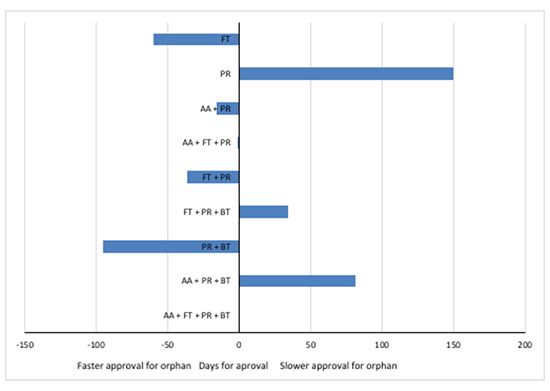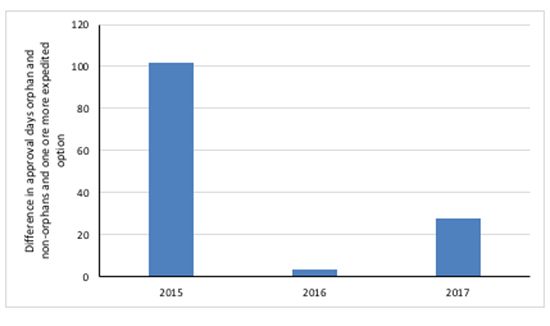Does Being an Orphan Speed Up FDA Approval?
Leela Barham looks at whether there is a boost to the speed of FDA approval when a drug not only secures one or more of the FDA’s expedited development and review methods, but also when they are also designated an orphan drug.
In another in a series exploring the use of expedited FDA approval options, Leela Barham looks to see if there is a boost to the speed of FDA approval when a drug not only secures one or more of the FDA’s expedited development and review methods, but when they are also designated an orphan drug.
Overlap between expedited review and orphan drug designation
There is an overlap between novel drugs approved using one or more FDA expedited development and review method and orphan drug designation. Taking the average over 2015 to 2017, 44 per cent of novel drug approvals using one or more expedited approval option were also an orphan.
No formal link between speed of approval and orphan designation
Whilst orphan drug designation does not set out expectations for the timing of drug approval, some in industry anecdotally suggest that it’s the orphan stamp that feels like it speeds things up when using expedited options at FDA. But is that the case?
Little evidence of a boost to the speed of approval
Taking a three-year perspective suggests that there is little difference in the median approval times when orphan designation is also in place when using one or more expedited option (Figure 1). There does appear to be greater variation in the speed of approval though, with the range including longer approval times for non-orphans.
Figure 1: Maximum, minimum and median approval times for novel drugs approved using one or more FDA expedited development and review method by orphan status, 2015 to 2017
Source: Analysis of FDA novel drug approvals data 2015, 2016 and 2017. Note excludes an extreme outlier in 2015.

Another way to dig a little more deeply into the question of whether there is an orphan drug boost to speed of approval is to compare the speed of approval for FDA expedited development and review options used in combination (another is looking at each of the options by themselves, but there’s not a clear reason why orphan status should boost one or another expedited option). Pooling the three years of data reveals that it’s a mixed bag; sometimes the orphan was approved faster, but sometimes not.
Figure 2: Difference in median approval times for combinations of FDA expedited approval options by orphan and non-orphan status, 2015 to 2017
Source: Analysis of FDA novel drug approvals data 2015, 2016 and 2017. Note excludes an extreme outlier in 2015.

Another way to cut the data is to look at trends over the three years. That does suggest – although it’s not been statistically tested – that there have been differences in the median speed of approval for orphans versus non-orphans when one or more expedited approval options were used in the past (Figure 3). However, the difference in the median speed in orphans and non-orphans for each year from 2015 to 2017 has been falling (Figure 4). So even if there was a difference, it might not have persisted to now.
Click here for Figure 3: Trend in approval times for novel drugs approved using one or more FDA expedited development and review method by orphan status, 2015 to 2017(Source: Analysis of FDA novel drug approvals data 2015, 2016 and 2017. Note excludes an extreme outlier in 2015.)
Figure 4: Trend in the difference in median approval times for novel drugs approved using one or more FDA expedited development and review method by orphan status, 2015 to 2017
Source: Analysis of FDA novel drug approvals data 2015, 2016 and 2017. Note excludes an extreme outlier in 2015.

Should orphan drugs be approved faster?
Orphan drug status is not linked to achieving faster FDA approval as a matter of current policy, and it doesn’t seem it is in practice in recent years either. The FDA already has a job in trying to tackle the back-log of applications for orphan drug designation. Next could be also speeding up approval, something that is already being discussed.
Leela Barham is a freelance health economist and policy expert. You can reach her on leels@btinternet.com. She is providing input as a subject matter expert into medicines pricing policy development with a UK government client and for the duration of her involvement in that project, she is restricted on what she can write about.
Navigating Distrust: Pharma in the Age of Social Media
February 18th 2025Ian Baer, Founder and CEO of Sooth, discusses how the growing distrust in social media will impact industry marketing strategies and the relationships between pharmaceutical companies and the patients they aim to serve. He also explains dark social, how to combat misinformation, closing the trust gap, and more.
FDA Grants Priority Review to Regeneron’s Eylea for Macular Edema Following Retinal Vein Occlusion
April 18th 2025Regulatory action was based on data from the Phase III QUASAR trial, which demonstrated that Eylea HD dosed every eight weeks achieved non-inferior visual acuity outcomes compared to Eylea in patients with macular edema following retinal vein occlusion.